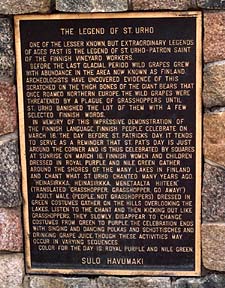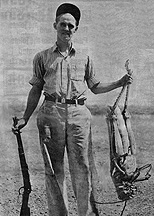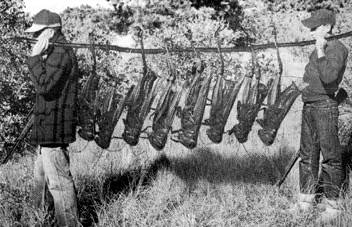

|
|
|
"One of the lesser known, but extraordinary legends of ages past is the legend of St. Urho - Patron Saint of the Finnish vineyard workers.
"Before the last glacial period, wild grapes grew with abundance in the area now known as Finland. Archeologists have uncovered evidence of this scratched on the thigh bones of the giant bears that once roamed northern Europe. The grapes were threatened by a plague of grasshoppers until St. Urho banished the lot of them with a few selected Finnish words.  "In memory of this impressive demonstration of the Finnish language, Finnish people celebrate on March 16, the day before St. Patrick's Day. It tends to serve as a reminder that St. Pat's Day is just around the corner and is thus celebrated by squares. At sunrise on March 16, Finnish women and children dressed in royal purple and nile green gather around the shores of the many lakes in Finland and chant what St. Urho chanted many years ago: "Heinasirkka, heinasirkka, menetaalta hiiteen." (Translated: "Grasshopper, grasshopper, go away!")
"In memory of this impressive demonstration of the Finnish language, Finnish people celebrate on March 16, the day before St. Patrick's Day. It tends to serve as a reminder that St. Pat's Day is just around the corner and is thus celebrated by squares. At sunrise on March 16, Finnish women and children dressed in royal purple and nile green gather around the shores of the many lakes in Finland and chant what St. Urho chanted many years ago: "Heinasirkka, heinasirkka, menetaalta hiiteen." (Translated: "Grasshopper, grasshopper, go away!")
"Adult male (people, not grasshoppers) dressed in green costumes gather on the hills overlooking the lakes, listen to the chant, and then kicking out like grasshoppers, they slowly disappear to change costumes from green to purple. The celebration ends with singing and dancing polkas and schottisches and drinking grape juice, though these activities may occur in varying sequences. "Color for the day is royal purple and nile green." This is the "official" legend of St. Urho - inscribed on the plaque on the first statue erected to the Finnish folk hero, in Menahga, Minnesota. In reality, none of it is true. St. Urho never existed, but that hasn't prevented every state in the union from declaring it an official holiday. It's all a tall tale that originated in Minnesota in 1956. But there are even disagreements about how the tale got started. The most widely held account credits the origin of the legend to a department store manager in Virginia, Minnesota. As Aini Rajanen recounts in the book "Of Finnish Ways" - "It started as a joke, when certain fun-loving members of a department store staff in Virginia, Minnesota, decided to turn the tables on their Finnish manager. On St. Patrick's Day he had been guilty of the heinous heresy of refusing to be impressed by the Irish claims for their saint. Pooh, said he. Finns have an even greater hero named Urho, and he told tall tales of the saint's mighty prowess. His staff bided their time. On the day which he had named as the feast day of St. Urho, they greeted him with a hand-carved nutcracker purporting to be the image of the saint, a frog, and a hand-lettered scroll on which an Irish lass (no less) had written a pidgin-Finn rhyme that sang the deeds of his legendary hero.Another possible origin of the legend credits a school district psychologist in St. Paul, Minnesota, with inventing St. Urho. Sulo Havumaki, who wrote the legend quoted above, supposedly created the Finnish folk hero in self-defense when he found himself surrounded by followers of St. Patrick in his office in City Hall. He taught at Bemidji State University, in Minnesota, where St. Urho used to chase a student dressed in a grasshopper costume through the classrooms. He died in 1970, but his widow was invited to break a bottle of wine over the toe of the Menahga statue when it was dedicated in 1982.  Variations of the legend describe the insects as locusts. Some claim that St. Urho wielded a rake; others say it was a pitchfork. There are also stories that purport that St. Patrick and St. Urho were one and the same. Supposedly, Urho heard reports of a plague of snakes in Ireland and set sail across the North Sea to lend a hand. The grateful Irish, unable to pronounce the Finnish name "Urho," (pronounced "oorlho") took to calling him The Patriarch. Eventually "Patriarch" became "Patrick."
Variations of the legend describe the insects as locusts. Some claim that St. Urho wielded a rake; others say it was a pitchfork. There are also stories that purport that St. Patrick and St. Urho were one and the same. Supposedly, Urho heard reports of a plague of snakes in Ireland and set sail across the North Sea to lend a hand. The grateful Irish, unable to pronounce the Finnish name "Urho," (pronounced "oorlho") took to calling him The Patriarch. Eventually "Patriarch" became "Patrick."
A Modern-day St. Urho? Another Irish/Finnish connection recounts that, faced with a short growing season in Scandinavia, Finnish vintners would inject their grapes with vodka to boost their alcohol content. Not to be outdone, Irish barkeeps would add knockout drops to their watery whiskey to increase the potency. These concoctions proved powerful, and the two groups were forced to share the credit for the invention, which became known as a Mickey Finn. Depending on which version you believe, the words that St. Urho shouted to banish the plague of frogs/grasshoppers from his country, "Heinasirkka, heinasirkka, menetaalta hiiteen," may mean "Grasshopper, grasshopper, go to hell!" or "Grasshopper, grasshopper, get the hell out of here!"  No matter which version of the legend appeals to you the most, you have to admit that it's a great excuse for a party. And if you celebrate St. Patrick's Day too, you can stretch the celebration over a two-day period. But beware - those that consume too much purple and green beer have been known to see visions of giant grasshoppers looming on the horizon!
No matter which version of the legend appeals to you the most, you have to admit that it's a great excuse for a party. And if you celebrate St. Patrick's Day too, you can stretch the celebration over a two-day period. But beware - those that consume too much purple and green beer have been known to see visions of giant grasshoppers looming on the horizon!
Illonen St. Urho's Paivaa!!! (Happy St. Urho's Day!!!) |
|
Contents | St. Urho's Day | Mmmm...Chocolate! Recycle | Eve's Story | Etc. Critic's Corner | My $1.59 Worth | Point Of View Past Issues | E-Mail Me All information © 1998-99 by theWebGoddess. No portion of this site may be copied without permission. |